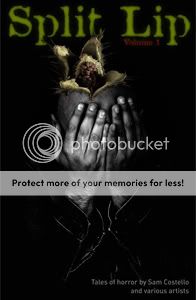
Split Lip Vol. 1
Sam Costello, writer
Josh Bivens, Diego Candia, Gary Crutchley, Nelson Evergreen, Ayhan Hayrula, Brian A. Laframboise, Iain Laurie, Sami Makkonen, Brian McGleenon, Felipe Sobreiro, Kyle Strahm, artists
Tent City, 2009
158 pages
$15
Read it and buy it at SplitLipComic.com
The back cover of this collection of astute horror writer and critic Sam Costello’s anthology webcomic reads in part, “Split Lip sheds traditional horror archetypes in favor of creating dark moods, original characters, and frightening experiences.” Of the three claims I think the first is the best supported. Somber and stark in almost every particular, from plotting to dialogue to his army of collaborators’ art, Costello’s comics quietly but relentlessly reinforce the simple fact that horror is about death. There’s a funereal sadness even in the less effective pieces here, a sense that the horror Costello’s interested in stems not so much from fright as from pessimism. After all, we’re all headed for our own down endings. So to me this offsets the lack of bona fide “frightening experiences”; contra the back cover blurb, I don’t even think that’s what these comics were even going for.
That said, the individual stories vary wildly not so much in quality–I never though “man, this is junk”–as in, like I implied above, effectiveness. Costello’s admirable reliance on the visuals to tell the key parts of his stories, in particular their climaxes or climactic twists, allows the work to rise and fall on how clearly his artists can tell the story, and on a couple of occasions the answer is “not very.” I was left flummoxed by what, exactly, happened at the end of the King-esque cornfield morality play “Straw Men” and the grim fairy tale “Fitcher’s Bird,” while crucial spatial shifts in “Not Sleeping Well,” “The Consequences of a Little Alone Time,” and “School Supplies” were inadequately contextualized. Moreover, stiff figurework on “Straw,” “Consequences,” and “The Executioner Is a Lonely Men” tends toward pulp-ifying fairly restrained writing and, to return to the blurb, mitigating against the originality of the characters. (Given my predilections, I’m tempted to suggest Costello try tapping artists with an out-and-out alternative flavor to them, but I don’t wanna armchair-quarterback this thing.) And on the rare occasion where Costello opts to do the heavy lifting himself, the Ciudad Juarez meets J-horror story “Mujer,” overnarration adds a layer of remove and does in a sense of the story as a living breathing thing.
But elsewhere the writing’s sharp as a knife. Whatever the shortcomings of its visually rushed ending, “Fitcher’s Bird” is kind of uncanny in how well it captures the dark dream logic of classic fairy tales and children’s stories, with their transformations, dismemberments, and ritualistic tasks that must be performed. And the art can shine as well as obscure: Kyle Strahm’s striking white-on-black work in the Western-horror fable “Headin’ South” radiates from the page with the power of agitprop and sets up a nifty negative-image punchline panel to boot. The best of the stories here, “The Tree of Remembrance,” combines strengths on both fronts. For Costello’s part, it’s his least “scary,” most straightforwardly melancholy piece, centered on a striking visual metaphor for the way memories of those we’ve lost can both haunt and heal. Aptly named artist Nelson Evergreen makes the best impression of any of the book’s visual contributors by making the most of Costello’s (according to the book’s supplemental material) uncharacteristically loose script in terms of layout and paneling–the story appears to drift to the ground just like leaves off the titular tree. But Evergreen really kills it with a pair of heartrendingly lovely images of the story’s elderly protagonist in the full bloom of her youth–ha, as I write this I’m listening to the lilting end section to My Bloody Valentine’s “What You Want,” and it’s pretty much the visual equivalent of that. And the pair unite for a starkly gruesome final panel that adds a welcome sour note to the sad sweetness of the proceedings up until that point. It takes a lot for a collaboration of this sort to work so effectively, so when it does it’s a treat, and it’s worth tuning in again to see how often Costello and his collaborators can recapture that moment.
Tags: comics, comics reviews, Comics Time, reviews
